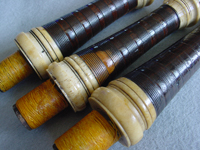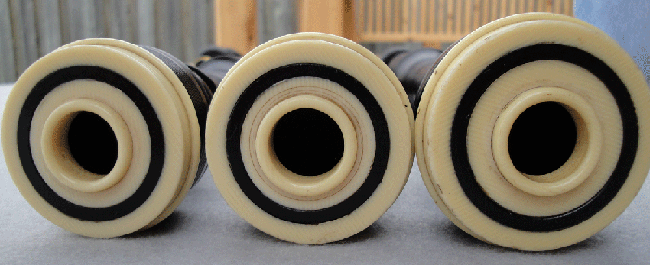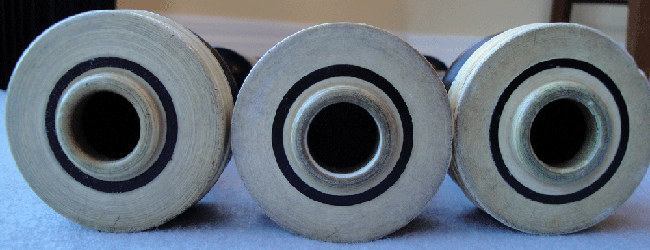Enjoying the pleasures of pipes past
Mounts

The earliest Highland pipes used bone and horn mounts. These were literally made from animal bone that had been boiled to remove all fat, then dried and turned on a lathe. From the mid-1800s, elephant ivory became the mount of choice. An 1893 article on Duncan MacDougall suggests his preference for ‘sea ivory,’ but in fact most of his pipes use elephant ivory. Sometimes brass and silver could be used for ferrules during the early years. This became more common as the 19th century progressed. Nickel (often called “German silver’) came into wide use after the 1850s.
Just before the turn of the century, imitation ivory made its appearance as new plastic and synthetic materials were developed. One of the earliest and best substitutes for ivory imitation ivory was a material called celluloid, which was the most realistic looking ivory substitute ever made. Unlike later materials such as catalin (which turned pumpkin orange over time) and casein (which broke down to a hideous chalk-like appearance) celluloid maintained its off-white patina and even showed an ivory-like grain. Celluloid continues to fool many knowledgeable pipers today, even though its production was discontinued in the 1940s due to its propensity for burning down warehouses and bursting into flame on the lathe. A second look will reveal that many vintage instruments believed to be ivory-mounted use this very convincing substitute.


Knowing makers
Identifying the makers of vintage pipes can be a quite a guessing game since so few makers stamp their name on their pipes. Pipe chanters are usually (but not always) stamped, but because tonal fashion changes frequently with pipe chanters, it is not that common to find a vintage bagpipe with its original chanter. The stamped chanter that does accompany a set of pipes is not necessarily the original chanter, even if it appears to be as old as the pipes. So it can rarely be used conclusively to identify the maker of a set of drones. Some makers stamped other parts, such as the chanter stock or bass drone stock, tuning chambers, tuning pins, or on an uncombed space on a drone section. These stamps can be so worn down now as to be nearly invisible, and are often only detected by accident.
The best identifiers of a bagpipe outside of a stamp are the turning styles of the mounts, and upper drone pieces, particularly the bells, though in this respect too, styles can change over time with particular makers, especially in the early days. Projecting mounts can . . .

I’m surprised there are not a number of comments or questions on this article – a lot of information, experience and work in the article, much of which was new to me. So glad the article was retrieved!